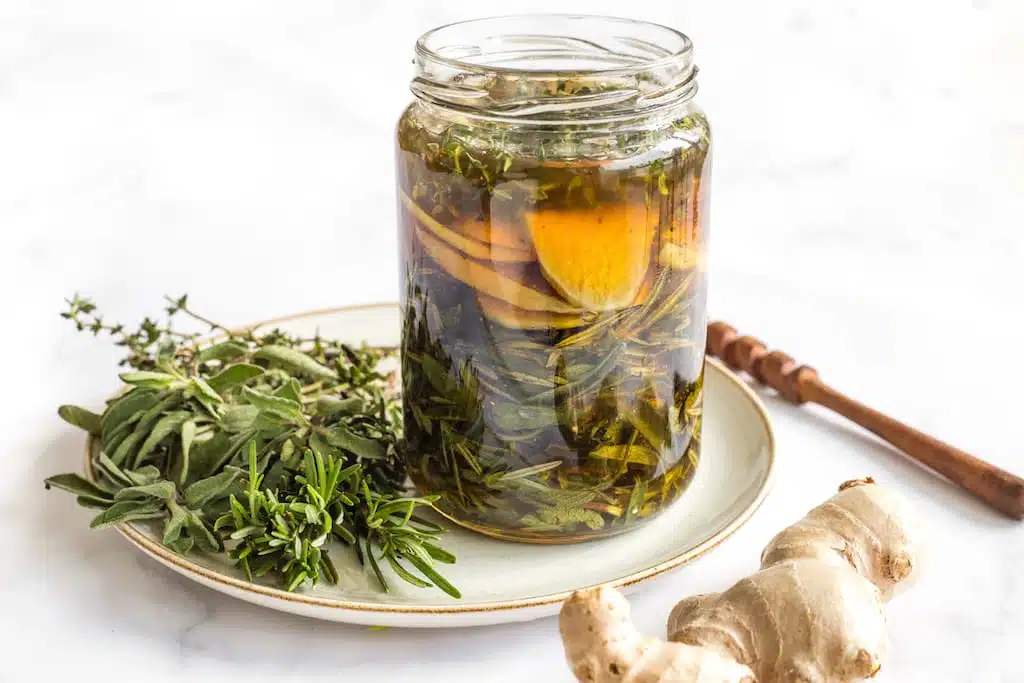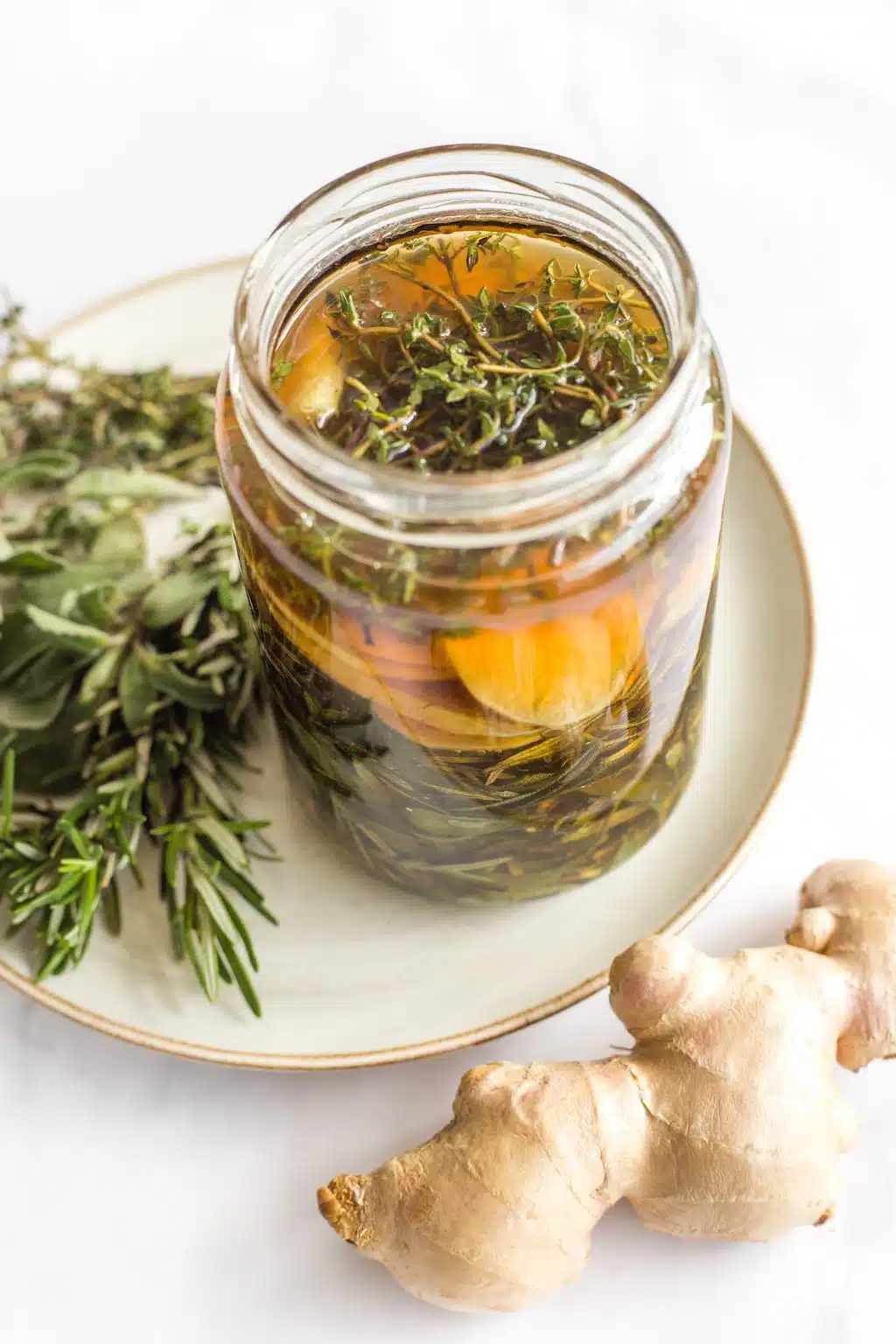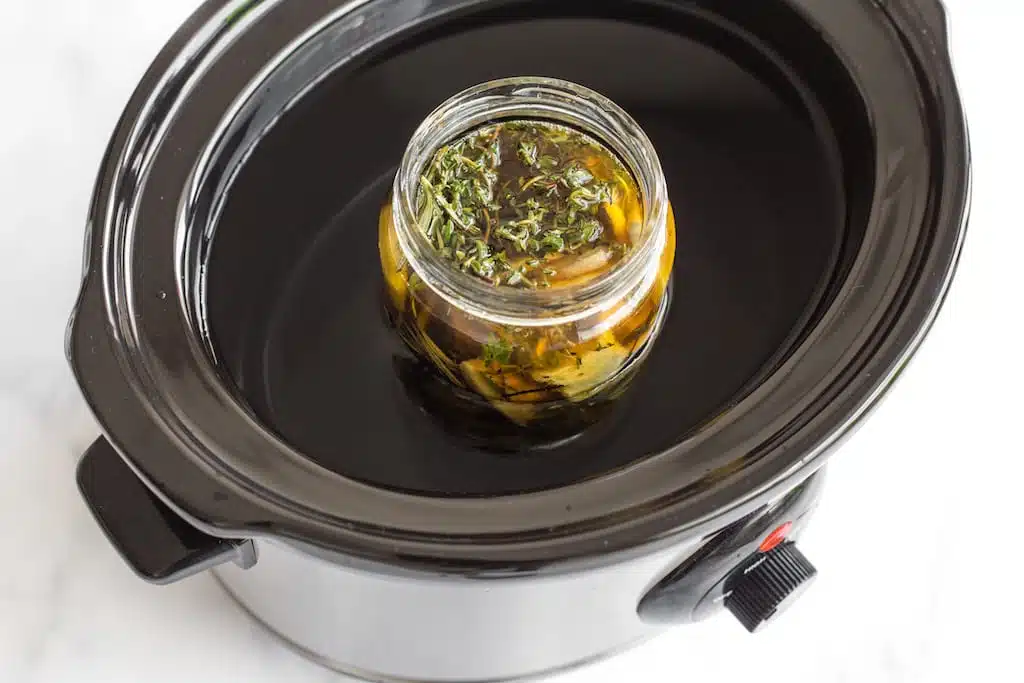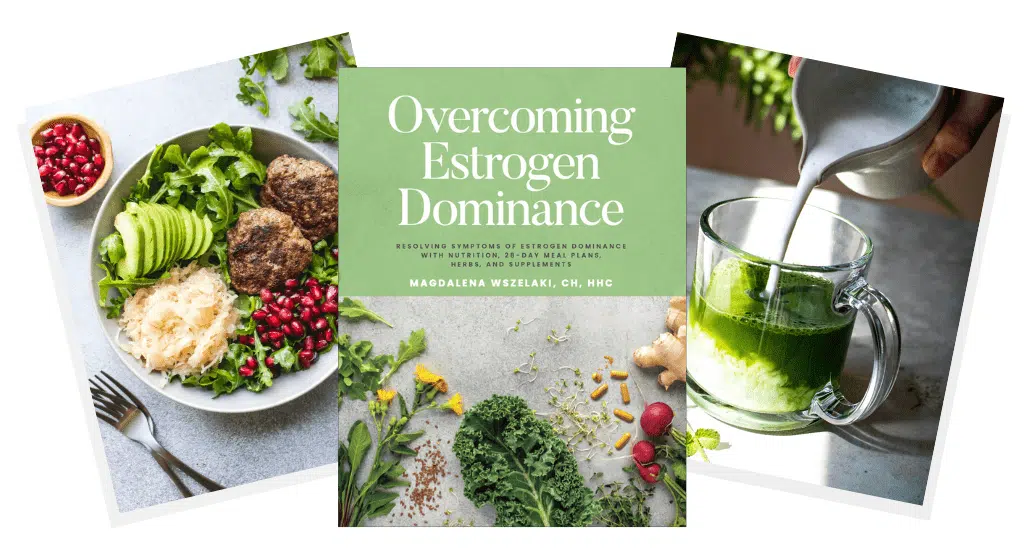
With fresh, potent botanicals and healing honey, this herbal honey infusion helps to balance hormones and ward off cold and flu.. What I love most about this infusion is that it need not be an exact science. You can have fun experimenting with different ingredients and ratios.
This low heat infusion process helps bring out the health benefits of each individual herb, and allows them to work together synergistically. Our recipe relies on four great herbs with many benefits to your health:
- Rosemary: An aromatic evergreen shrub, this herb is used in cuisines across the world, as well as cosmetics and body products. Studies have shown its medicinal benefits, including neuroprotective effects, pain relief, and helping with cognition and mood. With anti-inflammatory compounds and a dose of vitamin C, rosemary is great for immunity in cold and flu season.
- Sage: This herb has long been used in traditional medicine to protect the body from oxidative stress and free radical damage, as well as inflammation and infection. It’s a potent botanical with evidence for treating diseases such as depression, dementia, obesity, diabetes, lupus, heart disease, and cancer. Once again, this anti-inflammatory plant also delivers a great dose of vitamin C for immunity.
- Thyme: In thyme, you’ll find anti-inflammatory, antioxidant, antimicrobial, and antiseptic properties. It, too, is a powerful botanical. Herbalists have relied on thyme especially for relieving respiratory issues, both because of its antibacterial properties and because it’s a great expectorant, clearing out mucus.
- Ginger: Another good source of antioxidants, ginger also helps your body deal with oxidative stress and adds potent anti-inflammatory benefits. Ginger can also help alleviate nausea when sick.
Plus, you get the anti-inflammatory boost from fresh ginger root and all of the wonderful healing properties of honey. A slow, gentle warming process helps preserve the beneficial enzymes in the honey.
To get started, use the ratios of one part herbal material, and one and half parts honey, but please feel free to mix it up. The most important part is that you want the honey to completely cover your herbal material.
Tips:
- Using a funnel under the strainer may help there be less of a mess. Honey is a precious resource so try to not waste any with excess honey residue.
- Try to find creative ways to use the residue and leftover honey-soaked herbal material—like making a yummy sweet tea.
You can store an infused honey made with fresh herbs in the fridge to extend shelf-life (up to 6 months).
To learn more about how to balance your hormones with supplements (and which to take), you can download our FREE Supplement Guide here.
- ½ cup fresh rosemary
- ½ cup fresh sage
- ¼ fresh thyme
- ½ fresh ginger root (large/thin pieces) *so that it strains easy
- 1½ cup local honey
- Rinse herbs and fully dry.
- Crush herbs in a pestle and mortar to release the oils - this way they will infuse even more
- Place and press the herbs down in the mason jar. Entire jar should be filled with herbs to the top.
- Pour in honey and fully coat herbs.
- Stir (make sure all herbs are fully coated in honey). Add more honey if necessary to cover the top of the herbs.
- Put the jar in a crockpot and add water (not so high that the jar falls or gets water into it). Make sure to keep your jar uncovered and crockpot open so that the water in the honey and herbs can steam away. This gives the honey a longer shelf life. On the other hand, if you want to keep more of the aromatic essential oil compounds in there, you can lightly cover the vessel, but NEVER SEAL.
- Set to low and keep on crockpot for 6-12 hours. You want the honey to get warm enough that it is runny, but never bubbling. Adjust as needed, to make sure that honey does not get too high of a temperature (ideally kept between 100 to 130F).
- Strain the honey through a fine-mesh strainer while it's still hot (be careful your jar may be hot!)
- You can take a spoonful of the honey straight from the jar or stir it into tea.

Find more hormone-balancing recipes in Overcoming Estrogen Dominance
In Overcoming Estrogen Dominance, my goal is to empower and give you the tools to take control of your hormones and health.
More than 70% of women experience estrogen dominance. The symptoms range from lumpy and fibrocystic breasts to thyroid nodules, hot flashes, fibroids, uterine polyps, painful, heavy or irregular periods to infertility and miscarriages, from mood swings to insomnia, weight gain to fatigue.
In Overcoming Estrogen Dominance, I give women a roadmap to reverse estrogen dominance using food, herbs, supplements and natural protocols to rebalance hormones. You’ll also find easy, hormone-balancing recipes that are free of gluten, dairy, soy, corn, eggs, and nightshades. These recipes are highly anti-inflammatory, low in sugar, and made with powerful medicinal ingredients to help heal your body naturally.
To get your copy of Overcoming Estrogen Dominance, go here.



Hello and thank you for this great blog HERBAL HONEY FOR HORMONES AND IMMUNITY
I have been following your blog for a few weeks now and I greatly appreciate the quality of your articles.
Personally, what worked with me is this very effective method: https://bit.ly/Hormonesolution
So I offer it to you too because it helps thousands of people on a daily basis.
thank you and see you soon on other articles.
Cleef
How can you make this if you don’t have a crockpot?
Hi there,
You are welcome to use a pot on the stove, but you’d want to find the right temperature (not too hot where you burn the honey. but hot enough to infuse the honey with the herbs. A range of 105-130 degrees) You can bring your water to a boil and then bring it down to set the jar. Or, here are some stove top directions (just different herbs in this recipe) that might be easier to follow!
https://hormonesbalance.com/recipes/ginger-licorice-infused-honey/
Is it a 1/4 cup of fresh thyme and 1/2 cup of ginger? There seem to be some words missing in the recipe.
1/2 a ginger root and a 1/4 cup thyme
Hi Amanda, Hay is correct! The recipe calls for 1/2 a ginger root and 1/4 cup of thyme. ~HB Support
I’ve been told that heating honey lessens the potency…thoughts?
Hello,
I cant find a crockpot with a heating setting lower than 165 on the warm setting. The enzymes in honey die at 150.
Can you suggest a crockpot that works for this recipe?
Heating honey kills benefical bacteria…….seems rather conterproductive!!